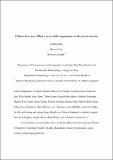Files in this item
Children draw more affiliative pictures following priming with third-party ostracism
Item metadata
| dc.contributor.author | Song, Ruiting | |
| dc.contributor.author | Over, Harriet | |
| dc.contributor.author | Carpenter, Malinda | |
| dc.date.accessioned | 2015-03-17T16:01:02Z | |
| dc.date.available | 2015-03-17T16:01:02Z | |
| dc.date.issued | 2015-06 | |
| dc.identifier | 175134405 | |
| dc.identifier | 1538a62b-fbcb-4c64-b4fa-25129c0d9f77 | |
| dc.identifier | 84930046207 | |
| dc.identifier | 000355169100009 | |
| dc.identifier.citation | Song , R , Over , H & Carpenter , M 2015 , ' Children draw more affiliative pictures following priming with third-party ostracism ' , Developmental Psychology , vol. 51 , no. 6 , pp. 831-840 . https://doi.org/10.1037/a0039176 | en |
| dc.identifier.issn | 0012-1649 | |
| dc.identifier.other | ORCID: /0000-0003-3983-2034/work/64698008 | |
| dc.identifier.uri | https://hdl.handle.net/10023/6255 | |
| dc.description.abstract | Humans have a strong need to belong. Thus, when signs of ostracism are detected, adults often feel motivated to affiliate with others in order to re-establish their social connections. This study investigated the importance of affiliation to young children following priming with ostracism. Four- and 5-year-old children were primed with either ostracism or control videos and their understanding of, and responses to, the videos were measured. Results showed that children were able to report that there was exclusion in the ostracism videos, and that they recognized that the ostracized individual felt sad. Most interestingly, when subsequently asked to draw a picture of themselves and their friend, children primed with ostracism depicted relationships that were significantly more affiliative. Children drew themselves and their friend standing significantly closer together and adults rated their drawings as more affiliative overall. These findings introduce drawing as a useful new method for measuring social motivations and processes following an experimental manipulation, and demonstrate that affiliation is particularly important to children following even a vicarious experience of social exclusion. | |
| dc.format.extent | 1499438 | |
| dc.language.iso | eng | |
| dc.relation.ispartof | Developmental Psychology | en |
| dc.subject | Ostracism | en |
| dc.subject | Affiliation | en |
| dc.subject | Drawing | en |
| dc.subject | Social development | en |
| dc.subject | Social motivation | en |
| dc.subject | BF Psychology | en |
| dc.subject | NDAS | en |
| dc.subject | SDG 10 - Reduced Inequalities | en |
| dc.subject.lcc | BF | en |
| dc.title | Children draw more affiliative pictures following priming with third-party ostracism | en |
| dc.type | Journal article | en |
| dc.contributor.institution | University of St Andrews. School of Psychology and Neuroscience | en |
| dc.contributor.institution | University of St Andrews. Centre for Social Learning & Cognitive Evolution | en |
| dc.identifier.doi | 10.1037/a0039176 | |
| dc.description.status | Peer reviewed | en |
This item appears in the following Collection(s)
Items in the St Andrews Research Repository are protected by copyright, with all rights reserved, unless otherwise indicated.

